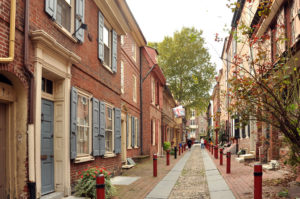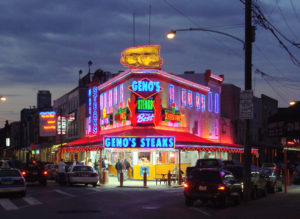Philadelphia is the largest city in the Commonwealth of Pennsylvania and the fifth-most populous in the United States. The area’s many universities and colleges make this great city a top international study destination, and it has evolved into an educational and economic hub.
Attractions

Philadelphia is home to many national historical sites that relate to the founding of the United States. Independence National Historical Park is the center of these historical landmarks. Independence Hall, where the Declaration of Independence was signed, and the Liberty Bell are the city’s most famous attractions. Other historic sites include homes for Edgar Allan Poe, Betsy Ross, and Thaddeus Kosciuszko, early government buildings like the First and Second Banks of the United States, Fort Mifflin, and the Gloria Dei (Old Swedes’) Church. Philadelphia alone has 67 National Historic Landmarks, the third most of any city in the country.
Philadelphia’s major science museums include the Franklin Institute, which contains the Benjamin Franklin National Memorial; the Academy of Natural Sciences; the Mütter Museum; and the University of Pennsylvania Museum of Archaeology and Anthropology. History museums include the National Constitution Center, the Atwater Kent Museum of Philadelphia History, the National Museum of American Jewish History, the African American Museum in Philadelphia, the Historical Society of Pennsylvania, the Grand Lodge of Free and Accepted Masons in the state of Pennsylvania and The Masonic Library.
Neighborhood Highlights
In Philly’s Downtown, along the Delaware River, lies Old City, bordered on the north by Vine Street, the East by Front Street, the south by Walnut Street and the west by 6th Street. This is the area where the Quakers and William Penn made their first settlements in the late 1600s. Today, it’s home to the Liberty Bell, Independence Hall, the Betsy Ross House and Elfreth’s Alley, where you can still see 300-year-old houses. Buildings here are predominantly in the Italianate and Greek Revival styles, and form the perfect setting for all of the international consulates located here.
In Old City, you’ll discover that around 3rd Street is one of Philly’s most happening nightlife areas, with galleries, bars and restaurants that attract a broad clientele all year round. There are also a number of movie theaters here that specialize in niche films like art movies.

Washington Square West is another Downtown neighborhood of historic significance. Bordered on the north by Independence Mall, on the east by Old City, on the south by Bella Vista and on the west by Rittenhouse Square, it was originally a pasture ground for Penn’s 17th century settlement.
Today, all that remains of the pasture is an urban park with the same name as the neighborhood. If you’re moving to Washington Square West, you’ll love its blend of stately buildings, including many in Federal, late Victorian and Georgian styles, built along streets that were planned in a grid fashion. Here you’ll find Philly’s Antique Row and the oldest hospital in the country, Pennsylvania Hospital. More modern buildings are a mix of commercial spaces and service offices with mid-rise apartment buildings and two- to four-story row houses.
Located in South Philly is Bella Vista, an Italian-American community that was home to the city’s first Italian immigrants. It’s a picturesque residential neighborhood with numerous coffee shops, cafés, bakeries and restaurants. Many locals here love art, and the Mew Gallery and the Fleischer Art Memorial welcome numerous visitors every year.
Passyunk Square, home to 13,300 residents, lies in South Philly, adjacent to Bella Vista. Though this was where George Washington’s troops were housed for a while in colonial times, it’s now a thriving and pleasant neighborhood. Large brownstones line the main streets and house numerous small businesses such as pharmacies and insurance companies. Along East Passyunk Avenue, you’ll find lots of retail shops and restaurants.

University City covers a large area in West Philly along the Schuylkill River and is home to some world-renowned educational, medical and science institutions. Here you’ll find the campuses of Drexel University and the University of Philadelphia, amongst others. The universities provide much of the funding to keep the neighborhood safe, clean and thriving. There’s a distinctly international atmosphere here, with students and researchers from across the globe living on the campuses, as well as in the surrounding late 19th and early 20th century homes.
In north Philly lies Fairmount, named for Fairmount Hill where the Philadelphia Museum of Art stands. With the world-famous Boathouse Row, Fairmount Water Works and Fairmount Park, one of the nation’s largest municipal parks, it is one of the most desirable neighborhoods in Philly today!
Kensington lies in the north of Philly and was once a thriving manufacturing hub for the textile industry. After suffering from decades of urban decay due to the relocation overseas of the textile factories, the neighborhood has successfully revitalized itself. Warehouse spaces have been repurposed as lofts, offices and restaurants, drawing more and more people who are eager to take advantage of spacious yet affordable living.
Named for the Fox Chase Inn that opened in 1705, Fox Chase, located in northeast Philadelphia, is often called the city’s “green heart.” If you’re moving to Fox Chase, you’ll notice its large amount of parkland, including the 9,000-acre Pennypack Park, as well as Fox Chase Farm, the last farm in the area that’s still operating.
Climate
You can expect hot and humid summers with daytime temperatures of around 77 degrees Fahrenheit. Winters are very cold, with temperatures averaging 32.5 degrees and wind chills making it feel even colder. The mildest seasons are spring and fall. All four seasons bring precipitation, though the end of winter and the beginning of fall are generally the driest times of year. Snowfall can be heavy one year and light the next, so you never know quite what to expect in Philly!
Philadelphia School District
The School District of Philadelphia is the eighth largest school district in the nation, by enrollment. Located in a historic and culturally rich setting, the school district is a racially and ethnically diverse community committed to education. The PSD has 218 district schools, 83 charter schools and almost 200,000 students. The school district is governed by a five-member School Reform Commission (SRC), established in December 2001, when oversight of the School District shifted to the Commonwealth of Pennsylvania. The Governor of Pennsylvania appoints three of the SRC members, while the Mayor of Philadelphia appoints two members of the commission.
